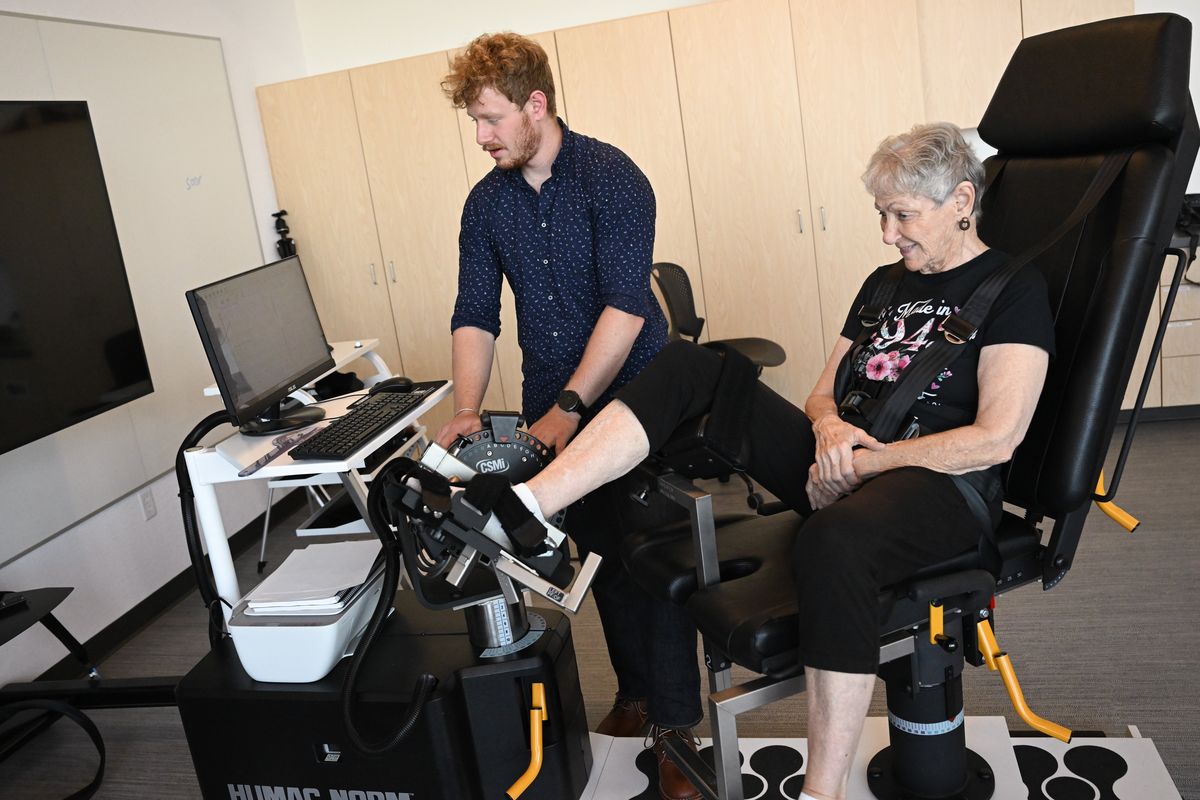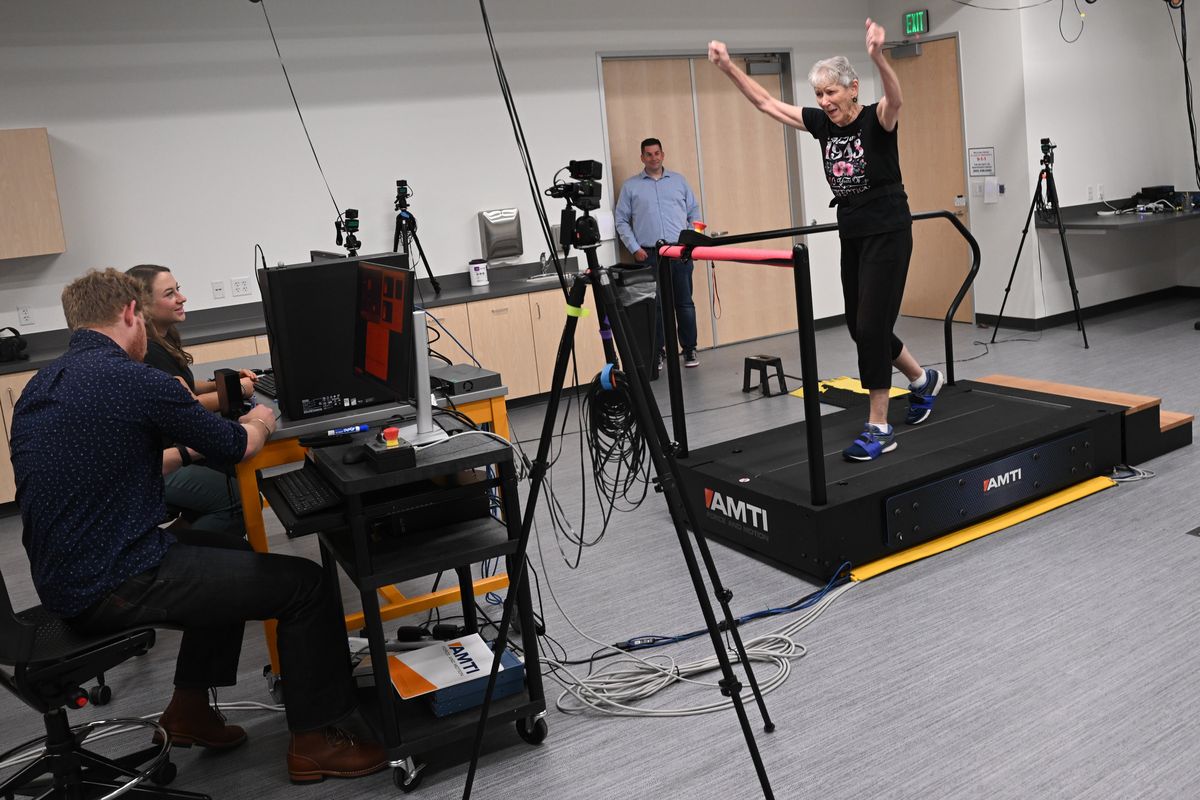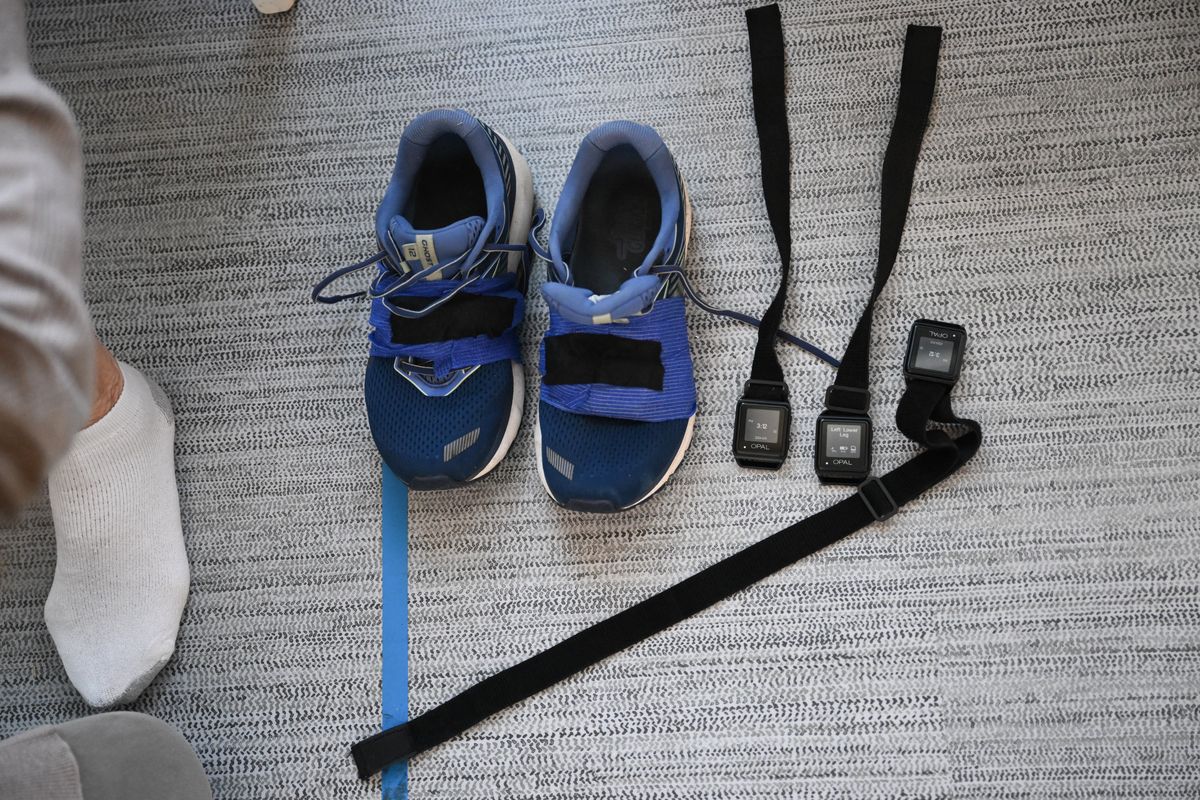GU partners with UW in new Parkinson’s research study focused on mobility
Hope Rolland, center, a volunteer participant in Gonzaga and the University of Washington School of Medicine’s research into Parkinson’s disease, reacts Thursday as she speed-walks through exercises on a specialized, instrumented split-belt treadmill while being monitored by seven motion-capture cameras run by GU Human Physiology majors Grace Fink, seated smiling, and Garrett Urvater, also seated. (Tyler Tjomsland/The Spokesman-Review)
Hope Rolland is active, fun-spirited and open to opportunities. At 81, she thrives despite Parkinson’s disease and has been doing so for some years.
On Thursday, Rolland agreed to a new challenge: being a participant in a mobility study led by Gonzaga University’s Department of Human Physiology in partnership with the University of Washington School of Medicine.
The study is under the direction of Clint Wutzke, an associate professor at Gonzaga in Human Physiology. He holds a Ph.D. in the field and has studied movement in multiple contexts.
This summer, he brought undergraduate and medical students together to facilitate a study on a disease that he said is under-researched.
The ultimate goal is to analyze how people with Parkinson’s fatigue differently in comparison with unimpaired people. Wutzke has 15 participants involved this summer, including seven who have the disease.
The American Association of Neurological Surgeons reported in April that Parkinson’s affects 1.5 million Americans. It is considered a progressive disorder, with both motor and nonmotor symptoms, according to the Mayo Clinic.
Specifically, there exists “damage or death of nerve cells” in the substantia nigra part of the brain, neurosurgeon Dr. Seunggu Han wrote for Medical News Today. That region produces dopamine, Han said.
Without dopamine, Wutzke says people struggle to move easily and steadily, leading to “bradykinesia, or the slowing of movement, and tremors.”
For Rolland, tremors were one indication for her neurologist, who diagnosed her in 2022. Often, patients receive their diagnosis via a process of “exclusion,” Wutzke added.
In order to participate, he looked for individuals between their 50s and early 80s. In addition, when it came to impaired people, Wutzke ensured everyone could “complete protocol” and was diagnosed at least six months prior.
One key feature of the study is that Wutzke was not interfering with impaired people’s medication regimens. While other Parkinson’s research means taking individuals off medicine to “assess differences,” he has “ethical issues” with that, considering it may mean altering a person’s routine and quality of life.
Often, participants “don’t like being off” their prescriptions, he mentioned.
Before the research began, the director spent a month preparing. He enlisted the help of his own Gonzaga students, Kate Barnett and Grace Fink, who both study human physiology. The students were joined by Mikala Haas, a second-year medical student at UW. Barnett and Hass’ work in the lab is funded by McKinstry.
Rolland started her time at the lab with a questionnaire administered by Haas. The UW student asked general questions regarding the date, year and location. This is one way the researchers gauge participants’ cognitive abilities and exercise their “multiprong approach” to studying the disease, Wutzke said.
Following that, Rolland hopped on equipment that’s central to Wutzke’s research: a split-belt treadmill that’s “worth a Lamborghini,” Wutzke said jokingly.
Students then set up computers and cameras calibrated and dispersed across the room in order to collect various angles of Rolland’s walking.
The treadmill started, and speeds were managed by students. Rolland seemed calm, and she laughed along with the students as she strode for a few minutes. She even showed off her fun shirt: black, with floral adornments and “Made in 1943” painted across.
Once her time on the treadmill was complete, students downloaded the recorded footage of her walking. Then, a sort of skeleton figure was placed over the videos of Rolland’s body walking as an outline, so that Wutzke and researchers could better analyze her movement. The footage was also spliced into a sequence that made it simpler to interpret the results.
Following a short rest, Rolland was seated in the next contraption: the Humac Norm. While it resembles a chair, its capabilities extend beyond that. With the help of certain “restraints,” parts of the body can be isolated, allowing Wutzke to “test a joint” of his choosing, he said.
On Thursday, Wutzke tested Rolland’s flexion and extension in both ankles with varying levels of weight.
“That’s it?” Rolland asked sarcastically upon completing the exercises.
Wutzke said this study is not going to result in a new medication or grand discovery. Rather, it functions as an opportunity to learn more about the movement of impaired folks in the hopes of using this data and that from other research to, for example, develop a physical activity program.
Even if there was a cure, “everyone with Parkinson’s would not be immediately” healed, he said. That’s why he feels this research is crucial to finding how best to manage the disease’s motor implications.





